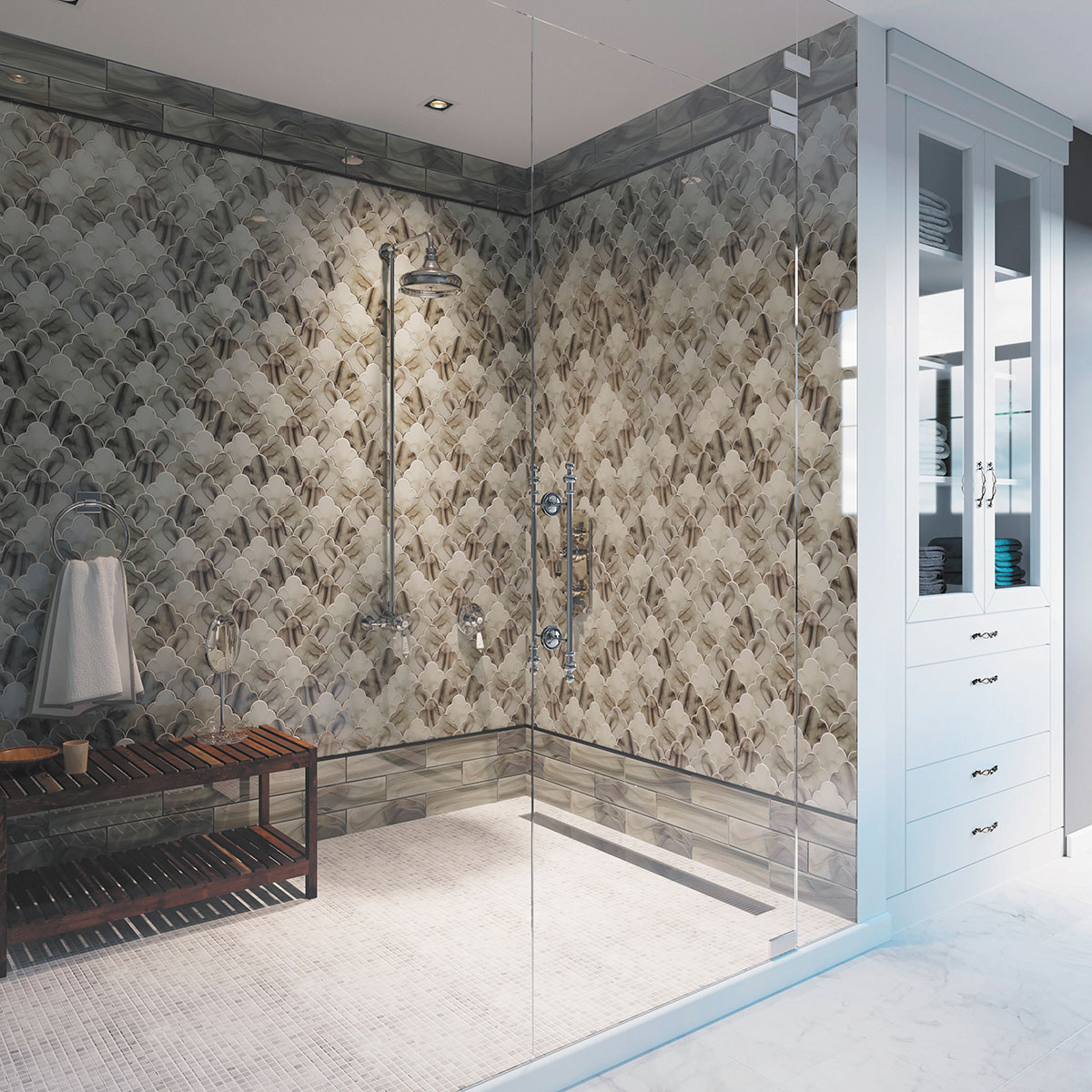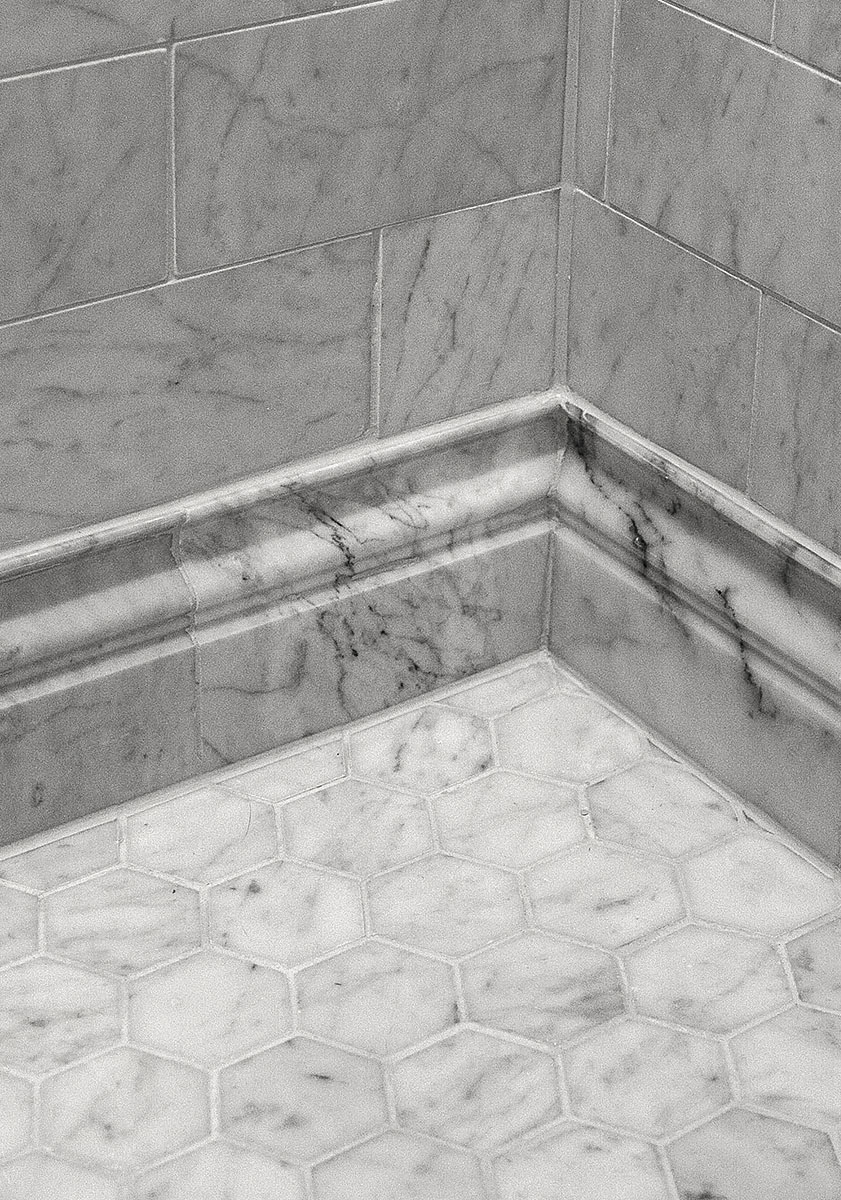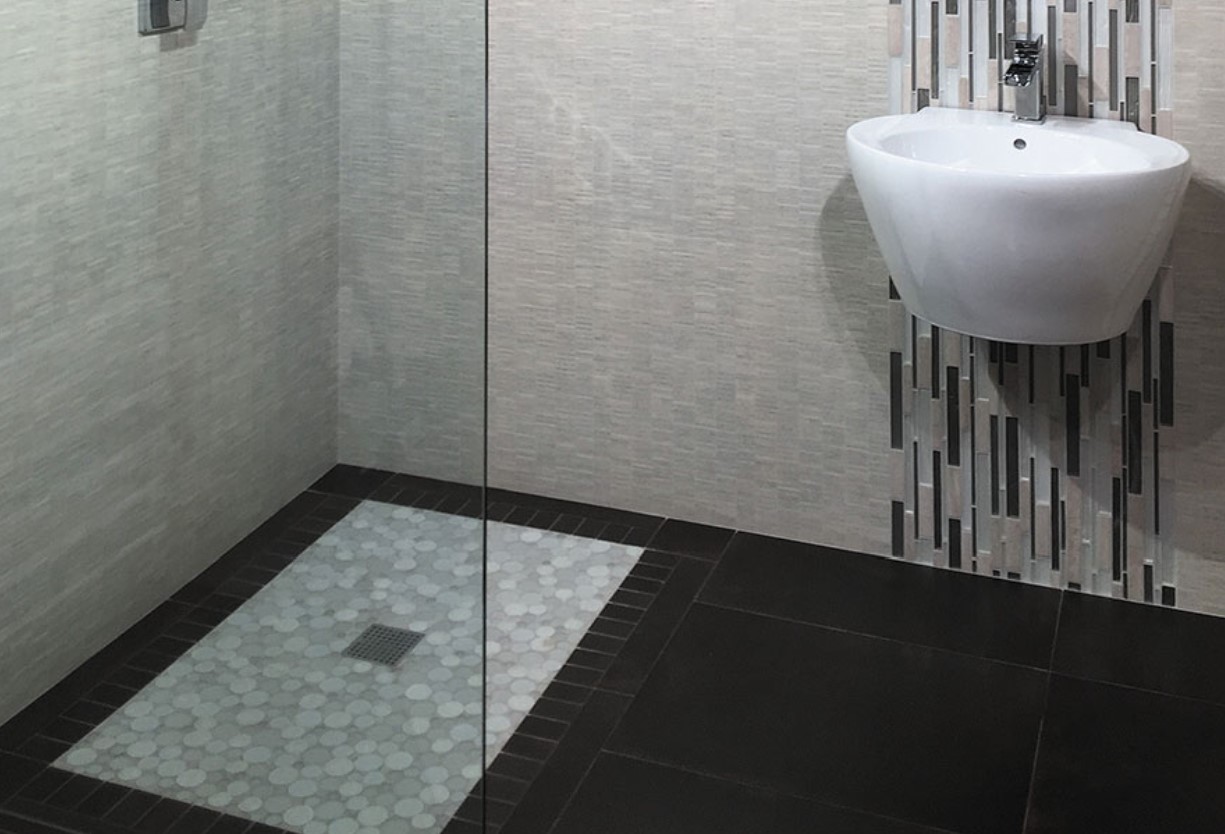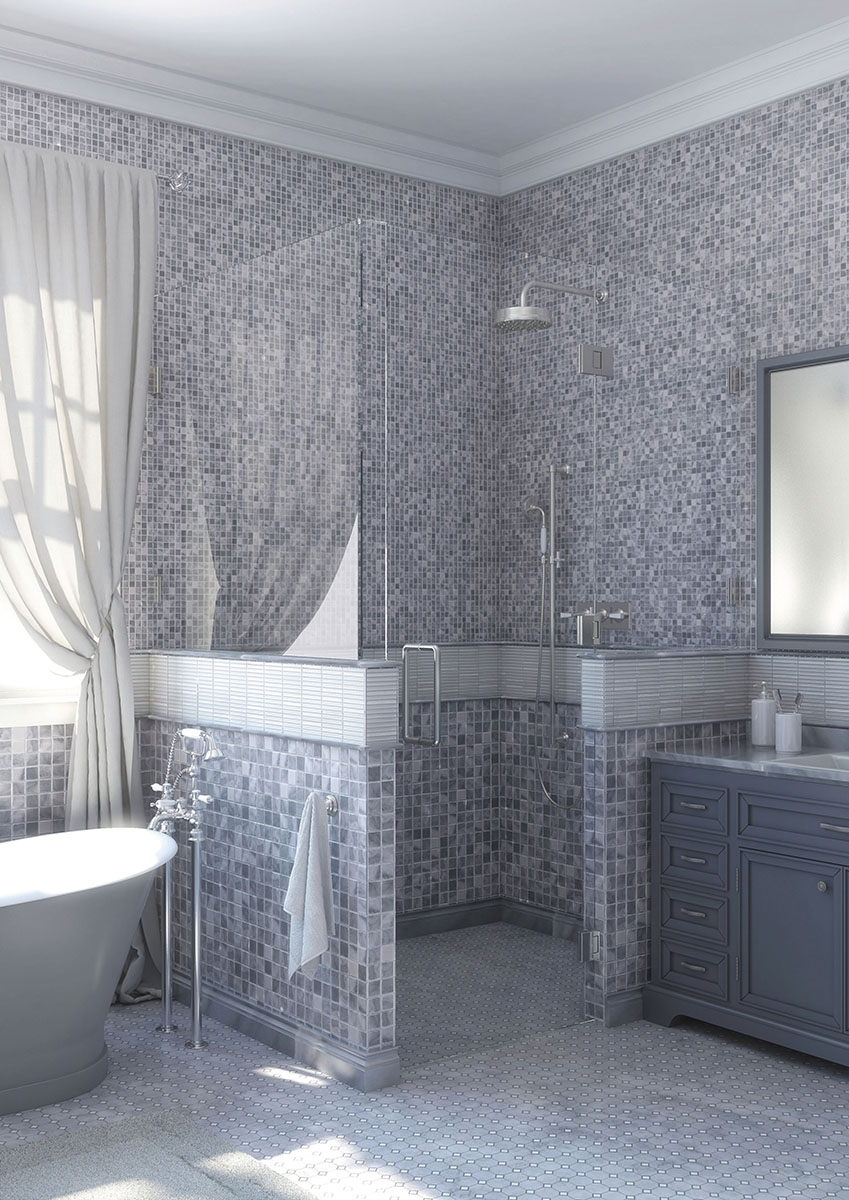Ultimate Guide to Choosing Shower Floor Tile
Posted by Mike Belk on Jul 24, 2024

When picking out tiles for your shower floor, it's really important to think about how slippery they might be. You should go for ones that have a bit of texture or are made up of small pieces like mosaics. These kinds give you better grip and help stop any accidents from happening.
With mosaic tiles being quite popular, their tiny size works well with the ups and downs of the shower base. Plus, they're good at preventing slips because there are more grout lines offering extra traction.

Porcelain and ceramic tiles are often chosen for these floors too since they last a long time and don't let water through easily. They come in lots of different looks and aren't hard to keep clean.
The amount of room you have in your shower matters when deciding on tile size. Smaller options, such as mosaics again, fit better on uneven surfaces making them simpler to install in tight spots.
Lastly, durability is key because your shower floor has got to handle lots of water use and foot traffic without wearing out quickly. Tiles made from strong stuff like porcelain, ceramic or natural stone will make sure your floor stays looking good as new for ages.
Introduction
Picking the right tiles for your shower floor is super important when you're sprucing up your bathroom. You want something that looks good, lasts a long time, and does its job well. With so many choices out there, deciding can feel like a big task. But don't worry; this guide has got everything covered to help you find the ideal shower floor tile. Whether you're looking for shower tile ideas or specific types of tiles like shower wall tile or shower accent tile, we've got you covered.
When it comes down to choosing these tiles, several things matter. First off, making sure they aren’t too slippery is key because nobody wants accidents in the bathroom. The size and shape of these tiles matter too since they affect how easy they are to put in place and how well they work afterward. What the tiles are made from is another thing to think about because some materials last longer and are easier to keep looking nice than others. Keeping up with what's trendy in shower floors can also make your choice stand out more positively or negatively depending on current tastes! And of course, putting them in correctly matters tons if you want them sticking around for ages without issues.
Whether mosaic pieces catch your eye or maybe pebble designs do it for you—or even porcelain ones—this guide will fill you in on all there is know about picking just right kind of durable floor tile for any style preference.
Understanding Shower Floor Tile Essentials
Before we dive into picking out tiles for your shower floor, let's get the basics down. Tiles made from natural stone like marble, slate, or travertine are often picked because they're tough and look great. But when it comes to keeping safe in the bathroom, making sure your tiles aren't too slippery is key. This is why choosing the right kind of floor tiles matters a lot. Different kinds have different levels of slip resistance. It's smart to go for ones that either have a bit of texture or are small mosaics which mean more grout lines - both can help you keep your grip better.
The Importance of Slip Resistance
When picking out tiles for your shower floor, making sure they're not too slippery is super important. Since bathrooms can get pretty wet and slick, choosing the right kind of tile that helps you keep your grip is key to avoiding falls and injuries. This is especially true if kids, older folks, or anyone who has a hard time moving around uses the bathroom. Going for tiles with some texture on them or ones that are made up of smaller pieces which mean more grout lines can really help cut down on slipping risks. It's all about keeping safety in mind when you're deciding on what bathroom tiles to go with, ensuring they stick to slip resistance standards so everyone can use the shower space without worry.
How the Size and Shape Affect Installation and Performance
When it comes to picking out floor tiles for your shower space, the size and shape really matter. With smaller tiles, like mosaics, you'll find they're not only easier to put in place but also great at adjusting to any uneven spots. They fit well with the slope and curves of your shower floor, making everything look neat and nicely done. On the flip side, going for bigger tiles means you've got to be extra careful when putting them down because they might need some trimming to get a perfect fit on your shower floor. So, it's pretty important to think about what kind of tiles will work best for your specific shower area, especially in terms of small size and shape, if you want everything looking good and working right.
Most Popular Types of Shower Floor Tiles
When talking about what to put on the bottom of your shower, a few types stand out. Mosaic tiles are pretty common because they're small and can easily fit any shape of the shower floor. They also help prevent slipping since there are lots of grout lines between them. Then, there's pebble tiles that look like natural stone and feel nice underfoot while helping you keep your grip because of their texture and surface variation. Porcelain tiles for the shower floor are liked by many too; they last a long time and don't let water through easily. You can find them in all sorts of looks, so it's easy to make your shower space match your style with these options.
Pros and Cons of Mosaic Tiles
Mosaic tiles are really liked for shower floors because they're small and can easily fit the floor's shape. They help prevent slipping thanks to lots of grout lines. Let's look at what makes them good and not so good:
- Pros:
- More grout lines mean less chance of slipping
- Fits well with the curve of your shower floor
- You get lots of design choices
- Simple to put in place, even on bumpy surfaces
- Cons:
- Needs more work to keep the grout clean
- The tiny tiles might be tough to scrub
- If you don't take care properly, there could be mold or mildew issues
Even with these downsides, mosaic tiles are still a top pick for many when it comes to making their shower floors both pretty and practical.
Exploring Marble Mosaics for Elegance
Marble tiles are a top pick for shower floors because they bring an elegant and timeless look. When you're thinking about designing your shower, marble mosaics really stand out by adding a touch of luxury. With their natural patterns, these tiles make the shower space pop with depth and personality, turning it into an eye-catching feature. You can go for the classic white marble or mix things up with darker shades like black or green to boost your bathroom's style even more. On top of looking great, matte marble is also tough and water-resistant, making it perfect for showers. As long as you keep them well-sealed and maintained, these durable tiles will keep your bathroom looking classy for years to come.

Innovative Materials for Shower Floors
Besides the usual picks like porcelain and natural stone, you've got some cool new options for shower floors. Ceramic shower floor tiles are a big hit because they last long and come in lots of designs without breaking the bank. Then there's glass tiles and both vinyl or luxury vinyl tiles that bring something different to the table with their unique looks and ability to keep water out. When picking what's best for your shower space, it's key to think about what your shower needs and what you personally like.
The Rise of Porcelain and Ceramic Tiles
Lately, a lot of people are choosing porcelain and ceramic tiles for their shower floors because they last long and can fit in with lots of different looks. Porcelain tiles, known for their durability and water resistance, are especially popular for shower floors. They come in many colors, finishes, and designs, making it easy to find the best tile for your shower floor that meets both style and functionality. Similarly, ceramic tiles are also a top choice for shower floors due to their water resistance and diverse design options. When deciding between porcelain and ceramic tiles for your shower floor, consider your budget, preferred style, and the importance of water resistance.
Advantages of Natural Stone Tiles
Tiles made from natural stone, like marble, travertine, or slate, add a classic and fancy look to shower floors. They make any bathroom feel more elegant and sophisticated. Besides looking great, these tiles are also tough and long-lasting. They're up for the challenge of dealing with water all the time and lots of people walking on them. But remember, it's key to take good care of them by sealing them right so they don't get stained or soak up moisture. With a bit of attention now and then, your shower floor can look amazing for years thanks to its durable natural stone tiles, such as terracotta.
Design Trends in Shower Flooring
In the world of home design, shower floor trends are always changing, giving homeowners exciting new ways to make their bathrooms look stylish and modern. Nowadays, people often go for colors like gray, white, and black on their shower floors because they give off a clean and classy vibe. Also getting a lot of attention lately are hexagon-shaped floor tiles for the shower area. They stand out because of their unique shape and can really spice up your bathroom's style when mixed with different colors or materials. For example, incorporating black hexagon shower floor tile can achieve a minimal and modern look. By keeping up with these trends in your bathroom's design, you get to enjoy a space that’s not just practical but also looks great.
Embracing Color and Pattern
When it comes to picking out the floor for your shower, the colors and designs you choose are super important. They help make your bathroom look good and show off your style. It's not just about plain white floors anymore. People are getting into all sorts of cool colors, detailed designs, and different materials and textures to spice up their bathrooms. You can find everything from bright blues and greens to calm earthy tones and pretty flower designs. With mosaic tiles, you get a bunch of choices in both color and pattern which means you can really have fun designing your shower space. By going with what you like in terms of color and design on your shower floor, you end up with a place that’s both stylishly yours.
Geometric Shapes and Custom Designs
On top of choosing colors and patterns, adding geometric shapes and your own custom designs can really make your shower floor stand out. Using tiles shaped like hexagons or chevrons gives the bathroom a fresh, modern feel. By mixing these shapes with different colors and materials, you can create a shower floor that grabs everyone's attention. Going for custom designs like herringbone patterns or detailed mosaics lets you put a personal stamp on it, showing off what makes you unique. Whether you're all about keeping things simple and sleek or love going bold with eclectic styles, throwing in some geometric flair along with personalized touches to your shower floor will turn your bathroom into something truly special.

Installation Tips for Shower Floor Tiles
To make sure your shower floor lasts a long time and looks great, it's important to install it the right way. Here are some helpful hints:
- Before you start laying down any tiles, check that the surface of the shower floor is clean, doesn't have any water on it, and is free from old bits of tile or dirt.
- When picking an adhesive, go for one that's made just for sticking down floor tiles in showers so everything stays put like it should.
- With grout lines, spacing them out correctly not only makes the whole thing look neat but also helps keep you from slipping. Use spacers that are all the same size to get this right.
- After putting down your tiles and grout,** seal them up** with a protective layer to stop water getting in and causing stains.
- Always stick to what both tile makers say about how best to do things as well as tried-and-tested methods.
By keeping these points in mind during installation, your shower floor will not only be safe thanks to its slip resistance, but also stay looking good without being ruined by moisture or dirty marks on your grout.
Preparing Your Shower Floor
Getting your shower floor ready is super important if you want to nail the tile laying part. First off, check that the base of your shower is spotless, not wet, and doesn't have stuff like old tiles or dirt hanging around. If there's any old flooring, yank it out and fix up places that are bumpy or damaged.
With that done, slap on a coat of mortar (or thinset) over the whole area where you're planning to lay tiles. This helps make everything flat so your tiles stick on right without wobbling. Grab a trowel and spread this mix all nice and even across the floor.
Now comes the fun bit - putting down those tiles! Kick things off from one corner and keep going until you've covered every inch. Pop in some spacers as you go along; they'll help keep all your tiles looking tidy by making sure they're all spaced out evenly.
After every single tile is exactly where it should be, give them time to bond with the mortar underneath just like how its maker says to do it. When everything’s rock solid underfoot – which means no shifting tiles – finish up by filling in gaps with grout for extra defense against water damage before sealing everything off nicely for a polished look.
Best Practices for Tile Layout and Grouting
To get a shower floor that looks like it was done by a pro and lasts long, you need to be careful about how you lay the tiles and fill in the gaps with grout. Start placing your tiles from the middle of the area and move towards the edges. This way, everything looks even and balanced. Don't forget to use little spacers between each tile so they all have equal space around them.
For filling those spaces, pick a grout color that goes well with your tiles and overall look of your shower. Follow what's written on its package for mixing it right then spread it into those gaps using something called a grout float. Be quick to clean off any extra grout on top of the tiles before it hardens up.
Once you've given time for this mixture between your tiles (grout) to dry completely, take a slightly wet sponge to gently wipe off any foggy film left behind on them. It’s important not only for good looks but also wait until this is fully set before letting water touch your new shower floor.
Keeping this part of your bathroom clean regularly will stop mold or mildew from showing up uninvitedly; applying something known as mildew-resistant sealer over these filled-in areas makes cleaning easier down road too.
Maintenance and Care for Longevity
To make sure your shower floor tiles last a long time, it's important to take good care of them. Here are some easy ways to keep your shower floor in top shape:
- By cleaning the shower floor often, you can get rid of soap scum, dirt, and grime. It's best to use a gentle cleaner that won't scratch things up and a soft brush or sponge for scrubbing both the tiles and grout.
- With regular checks on the grout lines for any mold or mildew signs is crucial too. When you see spots changing color or getting dark, clean those areas with something made for killing mildew or mix some bleach with water.
- Steer clear from tough cleaners that could harm the tile surface or mess up the grout.
- Thinking about applying a sealer on the grout lines might be wise as well; this helps guard against moisture getting in and stains sticking around. Just make sure to follow what its maker says about putting it on again when needed.
- After using the shower each time drying off the floor with either squeegee tool or towel will help stop water from hanging out there too long which prevents moldy patches.
By following these suggestions, your shower area should stay looking nice longer without much hassle
Regular Cleaning Tips
To make sure your shower floor tiles stay in top shape and to keep mold at bay, it's important to clean them regularly. Here's how you can maintain a spotless shower floor:
- With the aim of getting rid of any loose dirt or debris on the tiles and grout, start by sweeping with a broom or using a vacuum that has a soft brush attachment.
- For cleaning, mix warm water with a gentle cleaner that won't scratch. Using either a sponge or soft brush, apply this mixture onto your tiles and grout.
- When scrubbing the tiles and grout lightly, focus more on areas that are stained or look different in color. It’s crucial not to use harsh cleaners or rough brushes because they could harm both tile surface and grouting.
- After scrubbing, rinse off all soapiness from the tiles with plenty of clean water so no cleaning solution is left behind.
- To avoid leaving any marks from droplets of water—and also reduce chances for mold growth—dry off your shower floor well using either towel drying method.
By sticking to these simple steps for regular upkeep, you'll ensure those floor tiles remain looking neat while preventing issues like mold, especially around places where there’s lots of moisture like within shower floors and keeping everything sealed up tight including those pesky spaces between each tile known as grout lines
Dealing with Grout and Slipperiness
Grout isn't just there to fill gaps; it's key for keeping your shower floor tiles from being too slippery. Here are some ways you can handle grout to make sure your feet stay put:
- Picking a grout color that goes well with your tiles and stands out enough so you can see the lines clearly helps. If the grout is light in color, it might even make the floor seem less likely to cause slips.
- Choosing a type of grout that feels rough or has some texture could give better grip when walking on it.
- With an eye on wear and tear, regularly check if any of the grout lines are cracked or looking bad. Fixing these spots quickly reduces slipping hazards.
- Think about applying a sealer over the grout lines which makes them easier to keep clean while also protecting against water absorption, leading to fewer slip-ups.
- Be careful with cleaning agents as they sometimes leave behind slick residues. Always rinse off any cleaner thoroughly so no slippery film remains.
By sticking with these suggestions, you'll help ensure that stepping into your shower stays safe and worry-free thanks to improved slip resistance and sturdy traction underfoot provided by properly maintained grouts in those crucial shower floors areas where avoiding slipping is essential for safety
Safety Considerations for Shower Tiles
When picking out tiles for your shower floor, it's really important to think about safety first. Here are some tips on how to do that:
- Choose tiles that won't easily let you slip and fall. Look for ones with a rough surface or tiny mosaics because they help your feet grip better.
- Think about how much you need these non-slip features, especially if there are kids running around or someone at home doesn't move around too easily. You might want more slip-resistant options in those cases.
- Keep an eye on the condition of both the tiles and grout regularly. If you spot any cracks or loose pieces, get them fixed right away to keep the shower safe.
By focusing on getting floor tiles with good traction and keeping up with maintenance, you can make sure everyone stays safe while using the shower.
Selecting Tiles with the Right Texture
When picking out tiles for your shower floor, it's key to think about how rough or smooth they are and if they can help prevent slipping. Tiles that aren't too smooth and have a bit of grip to them can make the shower safer by lowering the chance of falling when it's wet.
Starting with choosing tiles, go for ones that either have a bumpy surface or are made up of tiny pieces which help in creating more grip under your feet. These kinds ensure you stay steady even on a damp floor. It's best to steer clear from shiny or sleek tiles since they tend to be more slippery.
On top of this, take into account how much slip resistance is necessary for your situation. For those who find moving around tricky or have little kids running about, picking out tiles that offer more stickiness might be wise.

By focusing on selecting floor tiles with suitable texture and slip resistance qualities for your shower area, you're taking steps towards making it a safer spot by cutting down the chances of accidents happening.
The Role of Grout Lines in Safety
Grout lines are super important when it comes to making the shower floor safe and less slippery. Here's a look at how they help:
- With grout lines, you get better grip because there's more space for water to go away, which means your feet can hold onto the floor better.
- When you use smaller tiles or mosaics that have lots of grout lines, you're actually making the floor less slippery since there’s more traction.
- It's also key to keep an eye on those grout lines for any cracks or damage. If they start looking bad, fixing them up quickly is important so your shower stays slip-resistant.
So basically, taking care of those grout lines not only keeps your shower looking good but makes it safer by boosting its slip resistance.
Cost Analysis of Shower Flooring Options
When choosing shower floor tiles, it's essential to consider the cost and budget for your project. Here's a cost analysis of different shower flooring options:
| Material | Price Range (per square foot) |
| Porcelain | $3 - $20 |
| Ceramic | $1 - $12 |
| Natural Stone | $5 - $45 |
| Mosaic | $5 - $35 |
These price ranges are approximate and can vary depending on factors such as the tile size, design, and the manufacturer. It's important to consider both the upfront cost and the long-term durability and maintenance requirements when selecting shower floor tiles.
Budgeting for Your Project
When planning how much to spend on your shower floor tiles, it's crucial to keep track of all the costs so you don't go over what you want to spend. Here are some steps to help:
- Start by figuring out your total budget for the project. This includes not just the tiles but also paying anyone who helps put them in, and any extra things like tools or decorations.
- With a variety of prices out there, look into different types of floor tiles for showers and see which ones fit into what you're willing to pay. Check out a cost analysis table for guidance.
- Think about what matters most to you in these tiles – is it making sure they aren’t slippery, that they last a long time, or how they look? Deciding this will help you know where best to use your money.
- Don’t forget about other expenses like putting the tiles in place and keeping them looking good over time. Including these from the start gives you a clearer picture of what everything will really cost.
By being smart with your budgeting and clear on what features are key for your shower floor - whether that’s slip resistance, durability or just loving how it looks - picking affordable yet suitable floor tiles becomes easier along with ensuring enough room is left for accessories too.
Comparing Price Points Among Different Tile Types
When you're looking at different tiles for your shower floor, it's smart to think about the type of material they're made from, how long they'll last, and if they give you a good bang for your buck. Let me break down what you might spend on some popular tile choices:
- With porcelain tiles, expect to pay more because they are tough, don't let water through easily, and come in lots of styles. You could be spending anywhere between $2 and $10 for each square foot.
- Ceramic tiles won't hit your wallet as hard as porcelain ones do. Their prices usually fall between $1 and $8 per square foot. They also have plenty of designs to choose from and work well on shower floors if they keep you from slipping.
- Tiles made from natural stone like marble or granite can get pretty pricey due to their one-of-a-kind look and variations in color or pattern. Depending on what kind of stone we're talking about here—and its quality—you might see prices ranging from $5 all the way up to $20 per square foot.
- Mosaic tiles bring a lot of design flair with them but can vary widely in price—from around 5 bucks up to 15 bucks per square foot—based mostly on what materials were used along with how complex their patterns are.
So when picking out which tile fits best underfoot while taking showers into account not only costs but also things like durability against wear-and-tear over time plus resistance both slip-wise & against moisture should guide that decision-making process too!
Conclusion
When picking out the right tiles for your shower floor, it's all about finding that sweet spot between looks and practicality. You've got a bunch of choices like timeless marble mosaics or sleek porcelain tiles. It matters whether you're after something safe, stylish, or kind to the planet. Getting to grips with what you need to know before starting, how to put them in place properly, and keeping them looking good is crucial for nailing this project. Don't be shy about mixing in some colors, patterns or even your own unique twist that shows off who you are. By weighing up costs, thinking about slip resistance for safety's sake and staying on top of design trends can help guide you towards making a choice that not only works great but also looks amazing.
Frequently Asked Questions
What Tile Offers the Best Slip Resistance?
Porcelain and ceramic tiles stand out as the best options for shower floors because of their slip resistance. By choosing tiles that have a textured surface or are made up of small mosaics, you're making sure there's better traction, which keeps things safe when it gets wet.
Can I Install Shower Floor Tiles Myself?
Putting in floor tiles on your shower floor can definitely be a do-it-yourself task, especially if you've got some know-how about laying tiles. But remember, it's crucial to stick to the best methods and make sure you have the right skills and tools for the job. On the other hand, if this makes you feel uncertain, getting a pro to do it might be your safest bet to guarantee everything is set up correctly.
How Do I Choose the Right Tile Size for My Shower Floor?
When picking out the perfect tile size for your shower floor, think about how big your shower space is, what works best functionally, and what looks good. For smaller showers, tiny tiles or mosaics are a great choice because they fit well. On the other hand, if you have a bigger shower area, going with larger tiles can give it a smooth and continuous look. It's all about finding something that meets both your practical needs and personal taste.
What's the Best Way to Clean Shower Floor Tiles?
To keep your shower floor tiles looking shiny and new, it's important to clean them regularly. Start by using a gentle detergent or cleaner made for tiles to get rid of any dirt and grime that's built up. When you come across tougher spots like stains or mold, especially in the grout lines, turning to a mix of vinegar and water can do wonders. Just apply this mixture where needed, wait a bit before scrubbing softly with a brush meant for such tasks. After cleaning, make sure you rinse off all the soapiness with plenty of water and then dry everything well so there are no water marks left behind.
With some care focused on areas more likely to gather stains or mold—think about those grout lines between your floor tiles—you'll manage keeping things spotless much easier. Remembering these steps will help ensure your shower floor stays welcoming and clean.
Are There Eco-Friendly Shower Floor Options?
Looking for shower floor options that are kind to the planet? You're in the right place. There's a bunch of eco-friendly choices out there, especially if you focus on materials like recycled glass or natural stone. These aren't just good for Mother Earth; they also make your bathroom look pretty cool.
When it comes to picking out tiles for your shower floor, going green is totally doable. Recycled glass tiles stand out because they come from things people have already used and tossed away. This means less stuff ending up in our landfills, which is awesome. Plus, these tiles can really brighten up your space with their looks alone! Then there's slate along with other types of natural stone tiles—these guys come straight from the earth and when you’re done with them down the line, they can be given a new life or broken down naturally without harming the environment much at all.
By choosing these kinds of materials—recycled glass or stones like marble and slate—you're not just making your bathroom look better; you're also doing a solid favor for our planet.
How Often Should Shower Floor Tiles Be Replaced?
When it comes to figuring out how often you should swap out your shower floor tiles, a few things come into play. It's all about what kind of tiles they are, how well they were put in, and how good you are at keeping them clean. If you've got tough and durable floor tiles that get the care they need, chances are they'll stick around for quite some time before needing to be replaced. On the flip side, if your shower floor starts showing signs of wear like cracks or chips or gets stains that just won't go away no matter what you do, then it might be time to think about getting new ones.
With various factors at work such as tile type, installation quality and maintenance level determining their lifespan; durable shower floors can really stand up to daily use without giving in too soon. But when damage does show up making them look less than great despite attempts at cleaning or fixing them - replacing may become necessary. Keeping an eye on the state of your bathroom's ground by regularly checking for any problems helps keep those sturdy pieces lasting longer while avoiding early replacements.
What Are the Latest Trends in Shower Floor Tile Design?
When it comes to the latest in shower floor tile design, there's a lot of cool stuff happening. For starters, geometric shapes are really in. Think hexagon and penny tiles - they're not just for old-school floors anymore but are making showers look modern and chic. With these shapes, you can play around with patterns that catch the eye and make your shower space stand out.
Then there's color - bold is where it's at! Adding vibrant colors to your shower can turn it from just another part of your bathroom into a standout feature. It’s all about creating a space that feels alive and inviting.
Mixing up materials is another trend on the rise. By combining different types like porcelain with natural stone, you add layers of texture that give your shower floor depth and an interesting look that’s hard to ignore.
So when picking out tiles for your shower floor, don't shy away from experimenting with various patterns, popping colors, or mixing materials like natural stone and porcelain. These choices will help bring personality into your shower space while keeping up with current trends.



